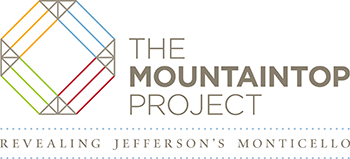
The unsolved case of the Jefferson curtain hardware!
How do you locate evidence for missing curtain hardware two hundred years after it was removed? Science! The Restoration Department recently used four different techniques to locate evidence for curtain hardware. First, a flash light was racked over the window trim to reveal any depressions or any raised areas that could show where nail holes had been filled with putty or spackle. Next, rare earth magnets were passed along the window trim to see if any hidden screws or nails were still imbedded in the window trim. Once these areas were identified, the nails that secure the trim to the framing were ruled out.
To identify fill holes that weren’t visible with either of the two previous steps, hand warmers were attached to the window trim (figure 1). The hand warmers reach a temperature of 158 degrees, which is hot enough to show up on the infrared camera but not hot enough to cause any damage to the historic trim. Once the trim reached a temperature above 100 degrees, the hand warmers were removed from the trim. An infrared camera was then used to locate filled holes not previously visible. This was possible because spackle and putty used to fill nail holes in the trim absorbs and radiates heat at different rates than the wood. When viewed with an infrared camera the heated wood shows up as golden yellow while the cooler, filled holes are a darker color (Figure 2). Finally, the areas that were determined to be in the right areas for curtain hardware were sampled by paint conservator Dr. Susan Buck to determine the number of layers in the paint sample (Figure 3). She’ll also investigate the chemical makeup of the paints and fill to see if they can be dated. With this information we may be able to determine if any of the filled holes were once part of Jefferson’s scheme for hanging curtains in the Cabinet. Be sure to come back and see what Dr. Buck discovered!

Photography from the infrared camera showing temperature of different areas with an anomaly in the bottom left corner.
The Mountaintop Project is made possible by a transformational contribution from David M. Rubenstein. Leading support was provided by Fritz and Claudine Kundrun, along with generous gifts and grants from the Sarah and Ross Perot, Jr. Foundation, the Robert H. Smith Family Foundation, Mr. and Mrs. John H. Birdsall, Mr. and Mrs. B. Grady Durham, the Mars Family, the Richard S. Reynolds Foundation, the National Endowment for the Humanities, Charlotte Moss and Barry Friedberg, the Joseph and Robert Cornell Memorial Foundation, the Mary Morton Parsons Foundation, the Cabell Foundation, the Garden Club of Virginia, and additional individuals, organizations, and foundations.





